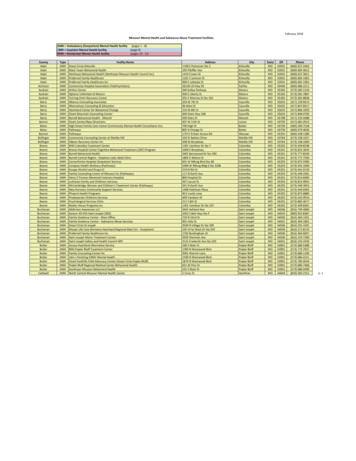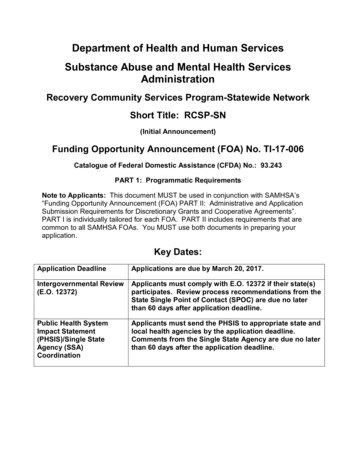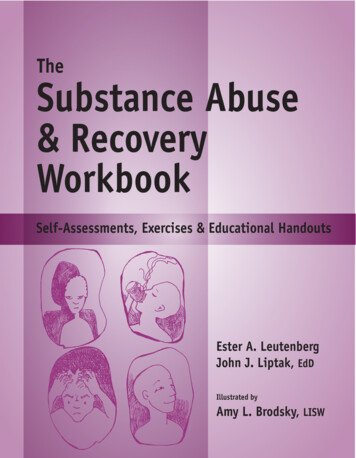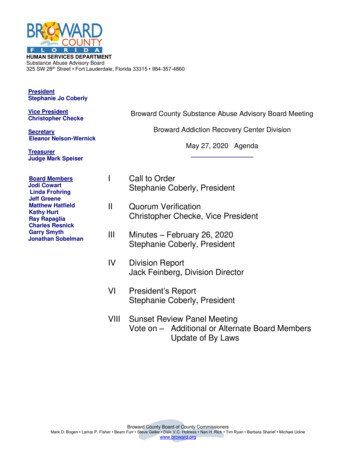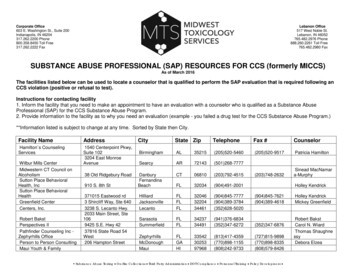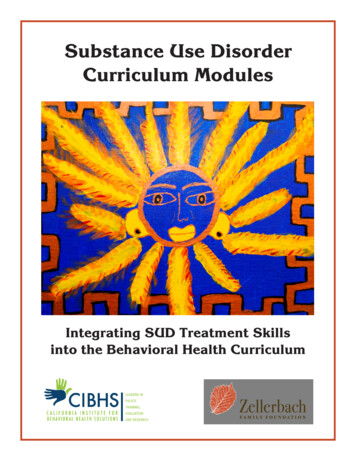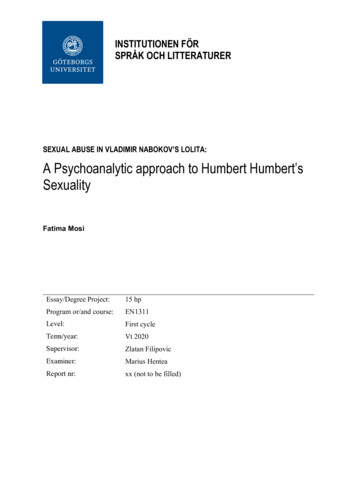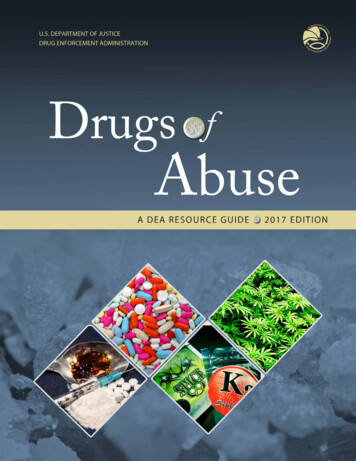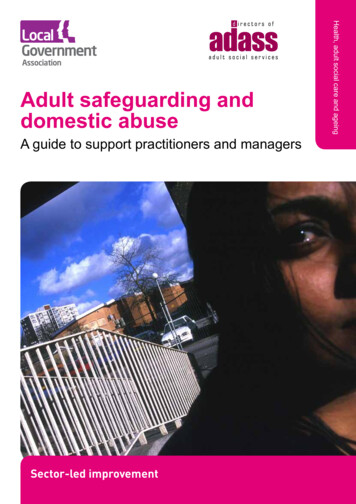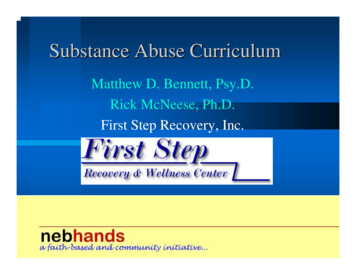
Transcription
Substance Abuse CurriculumMatthew D. Bennett, Psy.D.Rick McNeese, Ph.D.First Step Recovery, Inc.
Matthew D. Bennett, Psy.D.Rick McNeese, Ph.D.First Step Recovery, Inc.Lincoln, NEPart I: Overview
Defining our termsIn this presentation we’ll be using some technical jargon youshould get used to. The purpose of the jargon is not to throw youoff, but to help make sure we’re all talking about the same things!First we’ll review these concepts:1. What is the “substance” in substance abuse?2. What is “tolerance?”3. What’s the difference between “abuse” and “dependence”?5. What is “addiction”?6. Where does “alcoholism” fit in?
1. What is a “substance?”When we use the word “substance” in such as “substance abuse”or “substance dependence,” we are talking about drugs of abuse.Drugs of abuse are any chemical agents (natural or artificial) thataffect the mind and are known to be used in an abusive manner.9Alcohol9Illegal street drugs (such as marijuana or cocaine)9Addictive prescription drugs (like Xanax or Rohypnol)9Over the counter drugs (like Dramamine or even mouthwash)9Other mind altering substances (like model glue)
ClinicalClinicalFileFileDXM, a powerfulmind-altering drug,is very addictive. Itis found in manycough preparationssuch as coughsyrup.Science guy says:Cough syrup abusers can obtain their drug from their doctors bymaking up cold symptoms. Examples of cough preparationsinclude Robitussin AC, Dectuss, Phensedyl, Drixoral CoughLiquid Caps, and Pherazine with Codeine. (1)
2. What is “tolerance?”Tolerance is a word describing certain changes in the way anaddict reacts to a drug.A person who develops tolerance needs more and more of thedrug to get the same effect as before.For example, a person might be able to get a “buzz” after just acouple of beers in the beginning. But when dependencedevelops, the person is likely to need to drink more and more toget that buzz.
3. Substance Abuse vs. SubstanceDependenceSubstance Abuse basically means that a person’s use ofsubstances is causing problems in life (“failure to fulfill major roleobligations at work, school, or home”). For example, “alcoholabuse” would describe any use of alcohol that causes harm.The substance abuser may show lapses in parenting skills, jobfunctioning, or even legal charges (such as DUI) because of usingthe substance.A person diagnosed with substance abuse is not considered to beaddicted or dependent (otherwise the diagnosis would besubstance dependence). (2)
3. Substance Abuse vs. SubstanceDependence (continued)Substance Dependence is a more advanced problem,accompanied by certain changes in the way the person relates tothe substance. Signs of dependence include all the signs of abuseplus some additional problems:9Experiences withdrawal when not using9Seems unable to stop9Devotes a lot of time and energy to getting and using9Needs more and more to get the same effect (tolerance)9Gives up things that used to be important in order to use9Compulsions or cravings to keep using
Spotlight: DSM-IVFormal diagnosis of substanceabuse or dependence is madeby professionals based onstandards set by theDiagnostic and StatisticalManual of Mental Disorders(DSM). The current versionof the DSM is the DSM-IV (3).
4. What is “addiction?”Addiction is another way of saying “dependence.” When aperson is addicted to a drug, say for example alcohol, we refer tothe condition as “alcohol dependence.”As we have just learned, addiction (or dependence) is a syndromeincluding withdrawal symptoms, tolerance, inability to quit or cutback, and other problems.Science guy says:Addiction seems to have both apsychological and a physiologicalcomponent. More on this later.
5. Where does alcoholism fit in?Alcoholism is another way of saying “alcohol dependence.” Aperson diagnosed with alcoholism is therefore addicted to alcohol.Remember: addiction (or dependence) is a syndrome includingwithdrawal symptoms, tolerance, inability to quit or cut back, andother problems.So an alcoholic would show signs of withdrawal when notdrinking, would show increased tolerance to alcohol, would beunable to control the amount of drinking, and so on.
Matthew D. Bennett, Psy.D.Rick McNeese, Ph.D.First Step Recovery, Inc.Lincoln, NEPart II: Drugs of Abuse
Types of Drugs of AbuseAlcohol is a legal, addictive drug that depresses the central nervous system.Driving while intoxicated is illegal in all states in the US. Even after one drink(1 oz of hard liquor, 1 beer, 1 glass of wine), driving ability is impaired.Alcohol is cumulatively poisonous, and damages many organs of the bodywhen used excessively (including the brain, liver, and heart). Chronic, heavyuse of alcohol may lead to irreversible physical and neurological damage.In 2001, Nebraska logged96 DUI fatalities. (4)In Nebraska, a “drunkdriver” is defined as ablood alcohol content(BAC) of .08 or 8%. 1stoffense gets 90 dayslicense suspension. (5)
Types of Drugs of AbuseCocaine is a strong central nervous system stimulant that affects the distributionof dopamine, a chemical messenger associated with pleasure. Dopamine part ofthe brain's reward system and helps create the high that comes with cocaineconsumption. Cocaine usually looks like a white powder used for sniffing orsnorting, injecting, and smoking (in the case of free-base and crack cocaine).In addition to the desired high, cocaine may produce feelings of restlessness,irritability, and anxiety, or even mania or psychosis.Heroin is a very addictive drug processed from morphine, a substance extractedfrom the seedpod of the Asian poppy plant. Heroin produces a feeling ofeuphoria (a "rush") and often a warm flushing of the skin, dry mouth, andheavy feelings in the arms and legs. After the initial euphoria, the user may gointo an alternately wakeful and drowsy state. Heroin is the second mostfrequent cause of drug-related deaths.
Types of Drugs of AbuseMarijuana (weed, or cannabis) is one of the most common drugs of abuse inNebraska. Marijuana looks like a dry, shredded green/brown blend of flowers,stems, seeds, and leaves of a particular hemp plant. It usually is smoked as acigarette, pipe, or in blunts, which are cigars that have been emptied of tobaccoand refilled with marijuana. The main active chemical in marijuana is THC(delta-9-tetrahydrocannabinol), which quickly passes from the lungs into thebloodstream, and on to organs throughout the body, including the brain.Some of the short-term effects of marijuana use include problems with memoryand learning; bizarre or distorted perceptions; difficulty in problem solving;loss of coordination; and increased heart rate.A study has suggested that a user’s risk of heart attack morethan quadruples in the first hour after smoking marijuana. (6)
But marijuana isn’t evenaddictive, and besides,everybody does it!Wrong on both counts, actually. But this illustratesthe permission thoughts that serve to enablecontinued substance abuse. Permission thoughts(called “stinking thinking” in 12-step programs) makeit “okay” for the individual to keep using, and you’relikely to encounter them if you ask a user about his orher habits.
Types of Drugs of AbuseMethamphetamine (“meth”) is made in illegal laboratories and has a highpotential for abuse and dependence. It is often taken orally, snuffed, or injected.Methamphetamine hydrochloride, clear crystals resembling ice, can be inhaledby smoking, and is referred to as "ice," "crystal," and "glass." Use ofmethamphetamine produces a fast euphoria, and often, fast addiction. Chronic,heavy use of methamphetamine can produce a psychotic disorder which is hardto tell apart from schizophrenia (methamphetamine induced psychosis). Thedrug also causes increased heart rate and irreversible damage to blood vessels.According to the Arrestee DrugAbuse Monitoring Program, 11percent of adult male arrestees inOmaha tested positive formethamphetamine in 2000. (7)Meth produced by Mexicancriminal groups in Mexico,California, and southwesternstates is the predominant typeavailable in Nebraska. (8)
Types of Drugs of AbuseEcstasy (MDMA) is the so-called “party drug," It has both stimulant (likecocaine) and hallucinogenic (like LSD) effects. Ecstasy is neurotoxic(poisonous to brain cells), and in high doses it causes a steep increases in bodytemperature leading to muscle breakdown, and possible organ failure. Sideeffects may last for weeks after use, and including high blood pressure,faintness, confusion, depression, sleep problems, anxiety, and paranoia. (9)Acid (LSD) LSD, also called "acid," is sold in the street in tablets, capsules, oreven liquid form. It is clear and odorless, and is usually taken by mouth. OftenLSD is added to pieces of absorbent paper divided into small decorated squares,each containing one dose. LSD is a hallucinogen and a very powerful moodaltering chemical. (10)
Types of Drugs of AbusePrescription drugs. Using a prescription drug in a manner otherthan the intended prescription constitutes drug abuse. Some of themore commonly abused prescription drugs are:9 Pain-relieving narcotics (Percodan, Codeine, Vicodin,Percocet )9 Tranquilizers and sedatives (Halcion, Xanax, Ativan, Valium,BuSpar, Valium, Phenobarbital)9 Muscle relaxants (Soma)9 Prescription amphetamines (Ritalin, Cylert, Adderall)9 OxyContin
Types of Drugs of AbuseOver the counter drugs. Many different types of over-the-counterdrugs and other substances can be abused. Just a few examplesinclude:9 Inhalants (paint thinners, nitrous oxide, model glue, magicmarker fluid, spray paints, propane, butane, etc.)9 Dramamine9 Mouthwashes9 Diet aids9 Cough and cold medications (especially those containingDXM, like Drixoral Cough Liquid Caps, Robitussin AC,Dectuss, Phenergan etc.)
I don’t do any HARDdrugs.This is another example of apermission thought. The distinctionbetween “hard” and “soft” drugs isactually meaningless because ALLdrugs of abuse can lead to the sameconsequence .addiction.Once a person becomes addicted to ONE drug(marijuana, alcohol, prescription meds, heroin, etc),he or she is as good as addicted to ALL drugs ofabuse. For this reason, we train addicts forABSTINENCE from all drugs of abuse.
Do doctors always know best?Educate your doctor? All this talk about abuse of medicationsmakes you wonder: are physicians aware of how addictive thesedrugs can be?Many otherwise excellent physicians haven’t been well trained inthe addiction. During the four years doctors spend in medicalschool, addiction issues often get little attention. A doctor may notrecognize than even one pain-reliever pill can set off powerful anddestabilizing cravings in an addict.It’s a good idea for any addict to tell their doctor about his or heraddiction, and to get proactive about avoiding all drugs of abuse.
Matthew D. Bennett, Psy.D.Rick McNeese, Ph.D.First Step Recovery, Inc.Lincoln, NEPart III: Concepts in SubstanceAbuse
Reviewing our termsNow you should be familiar with these important concepts. If youneed to review, go back until you’ve got it.1. What is the “substance” in substance abuse?2. What is “tolerance?”3. What’s the difference between “abuse” and “dependence”?4. What is “addiction”?5. Where does “alcoholism” fit in?
Characteristics of DependenceLet’s look at four important dimensions of addiction. Addiction is:9 Chronic9 Primary9 Progressive9 IncurableLet’s review each concept in turn so that we know what thismeans.
1. Addiction is CHRONICA disorder that is CHRONIC continues for a long time. Theopposite of chronic is “acute,” which means relatively sudden andshort. Let’s look at other examples of chronic vs. acute disorders.Acute disordersFluFood poisoningConcussionChronic disordersDiabetesHypertensionEpilepsyNotice that “acute” disorders are treated once and they’re gone.“Chronic” disorders are managed, not cured.
2. Addiction is PRIMARYA disorder that is PRIMARY means that it is not the “result” ofsomething else. It is a disorder in its own right, requiring specifictreatment.For example, a man may start drinking to control the painfulfeelings of depression. However, when that man becomes analcoholic (addicted to alcohol), he now has a separate and“primary” disorder that needs treatment.Treating the depression does not mean the alcoholism will also goaway.
3. Addiction is PROGRESSIVEA disorder that is PROGRESSIVE tends to get worse over time.With drug addiction, we see that the consequences of theaddiction tend to worsen over time. One important mechanism ofthis progressive quality is tolerance, which we’ve discussed.The development of tolerance tends to ensure that a person has toget more, spend more, hide more, and use more over time.Later we’ll look at some of the particular consequences ofprogression, including medical problems.
4. Addiction is INCURABLEWe say that addiction is INCURABLE because the biologicalchanges involved in addiction tend to be permanent.As a result, an addict will never be able to safely use the drug ofabuse (or any other drugs of abuse). An alcoholic will never beable to “drink normally.”Likewise, a cocaine addict will never be safe using stimulatingdrugs (for example, ephedra, which is an over-the-counterstimulant). A person addicted to one drug can easily switch overthe another drug and still be an addict. This is called crossaddiction (more on this later).
Egads all this bad news!Primary, chronic,progressive, incurable Is there no hope?Of course there is hope!We said “incurable,” not “untreatable.” Remember the comparisonwith diabetes? We don’t cure diabetes, we manage it with properdiet, blood sugar monitoring, and other acts of discipline.Unfortunately, the addict rarely wants “discipline.” That’s whatmakes it so hard. By definition, an addict wants to keep using!
The Stages of ChangeNo discussion of addiction is complete without a quick look at the“Stages of Change” model, by Prochaska and DiClemente.Basically, the model describes 5 stages of change:1) Precontemplation2) Contemplation3) Preparation4) Action5) MaintenanceProchaska, J.O., & DiClemente, C.C. (1982). Transtheoretical therapy toward a moreintegrative model of change. Psychotherapy: Theory, Research and Practice, 19(3),276-287.
The Stages of Change, continuedPrecontemplationA person has no intention to change within the next 6 monthsContemplationA person to take action within the next 6 months.PreparationA person intends to take action within the next 30 days, andhas taken some concrete behavioral steps in this direction.ActionA person has changed overt behavior for less than 6 monthsMaintenanceA person has changed overt behavior for more than 6 months.
The Stages of Change, continuedOne reason it’s important to assess for stage of change is todetermine the right kind of intervention. For example, people in“precontemplation” probably aren’t ready to take treatmentseriously. Other examples of appropriately-timed interventions:1) Precontemplation: Encourage self-awareness, personalize risk2) Contemplation: Encourage analysis of the “pros and cons” ofchanging behavior; identify and promote new goals3) Preparation: Encourage the first small steps, identify socialsupport4) Action: Bolster self-efficacy, deal with feelings of loss, reinforcegains and benefits5) Maintenance: Plan follow-up support, reinforce internalrewards
Matthew D. Bennett, Psy.D.Rick McNeese, Ph.D.First Step Recovery, Inc.Lincoln, NEPart II: Biological Bases ofAddiction
Biological Bases of AddictionThis point that “addicts just want to keep using” brings us to animportant point about addiction and its biological roots.Science guy says:Addiction is associated with permanentchanges in the brain’s neurochemistry. Theaddict is biologically “programmed” to needthe drug in order to feel normal.Let’s take a quick look at what happens in the brain of an addict(without getting too technical).
Biological Bases: the reward centerFirst let’s take a look at a part ofthe human brain which has beencalled the “reward center” deep inthe brain. This area includesspecialized neural pathways whichprocess experience of pleasure.ClinicalClinicalFileFile3 elements of thereward center:- Medial forebrainbundle- Nucleus accumbens- Ventral tegmental
Biological Bases: the reward center(continued)The reward center seems to process many experiences ofpleasure, such as eating and sex. Experimental rats trained tostimulate their own reward centers with electric switches havebeen known to press on the switches thousands of times perhour! They neglect all other activities in order to keepstimulating themselves. (11)Does this kind of behavior sound familiar?
Biological Bases: The RewardCenter (continued)Now, you may not be surprised to learn that many drugs of abusestimulate the reward centers. As a result, using mind-alteringdrugs is pleasurable. The addict is almost like one of thoseexperimental rats, stimulating itself again and again, neglectinganything else.Doesn’t sound thatbad so far. What’swrong with a littlepleasure?
The problem is this: while the drugs are stimulating allthis pleasure, they also cause permanent changes.Repeated use of certain drugs of abuse can result in depletion ofbrain chemicals that allow the experience of pleasure.What happens next is this: more and more of the drug becomesnecessary to generate pleasure, and other sources of pleasure losetheir effects. Eventually, the addict can’t even feel just normalwithout the drug.As a result, the addict needs the drug to feel normal, and withoutit, they feel bad! It’s no longer a matter of pleasure it’s a matterof avoiding pain. This is the mechanism for tolerance.
Spotlight: DopamineThe brain chemicals thathelp generate pleasureare called dopamine, abrain chemical belongingto a group calledneurotransmitters.For example, both alcoholand heroin result in abuild-up of dopamine,resulting in ransmitterA “messengerchemical” in thebrain, which havemany differenteffects.
NeuroadaptationAs we discussed above, the brain adapts to this higher level ofdopamine in the system. It’s almost as if the body tries to“normalize” the new levels of pleasure by “raising the bar” toexperience pleasure. These changes are referred to asneuroadaptation.In other words, neuroadaptation means that it gets harder andharder to experience pleasure as you use more drugs. Addicts getthe point that only their drug .in ever-increasingamounts makes them feel good. (12)
The trap of addictionIn a sense, addicts get trapped by their own drug. They startedusing it to feel good, but end up needing it just to avoid feelingbad.But can’t the addictever go back tonormal? Even if hequits?
The Trap of Addiction (continued)Addicts can learn to experience pleasure in ways other than using.Unfortunately, research and clinical experience shows that thebiological changes are permanent.This is why addiction is considered incurable, as we discussedbefore.
Implications of addictionWe’ve seen now how repeated drug use causes permanentbiological changes in the brain. An important implication of thesechanges is this:Once an addict, always an addict.An addict can never assume it’s safe toresume using addictive drugs. Usingeven once will get the addict back toSquare One. 12-Step programs callthis “waking the tiger.”
Spotlight: 12-Step TraditionsIn 12-step programs, aperson commemoratesthe beginning of sobrietywith a “sobriety date.”If a person relapses, heor she starts with a newsobriety date.This tradition emphasizesthe fact that addictionnever “goes s is theworld’s largestsecret society,with over 2million membersworldwide.
The biology of cravingsGiving up drugs isn’t just a matter of giving up on the pleasure. Itcan be a very painful experience because of cravings.As we’ve discussed, the brain becomes “used to” the drugs ofabuse after r
(called “stinking thinking” in 12-step programs) make it “okay” for the individual to keep using, and you’re likely to encounter them if you ask a user about his or her habits. But mariju
